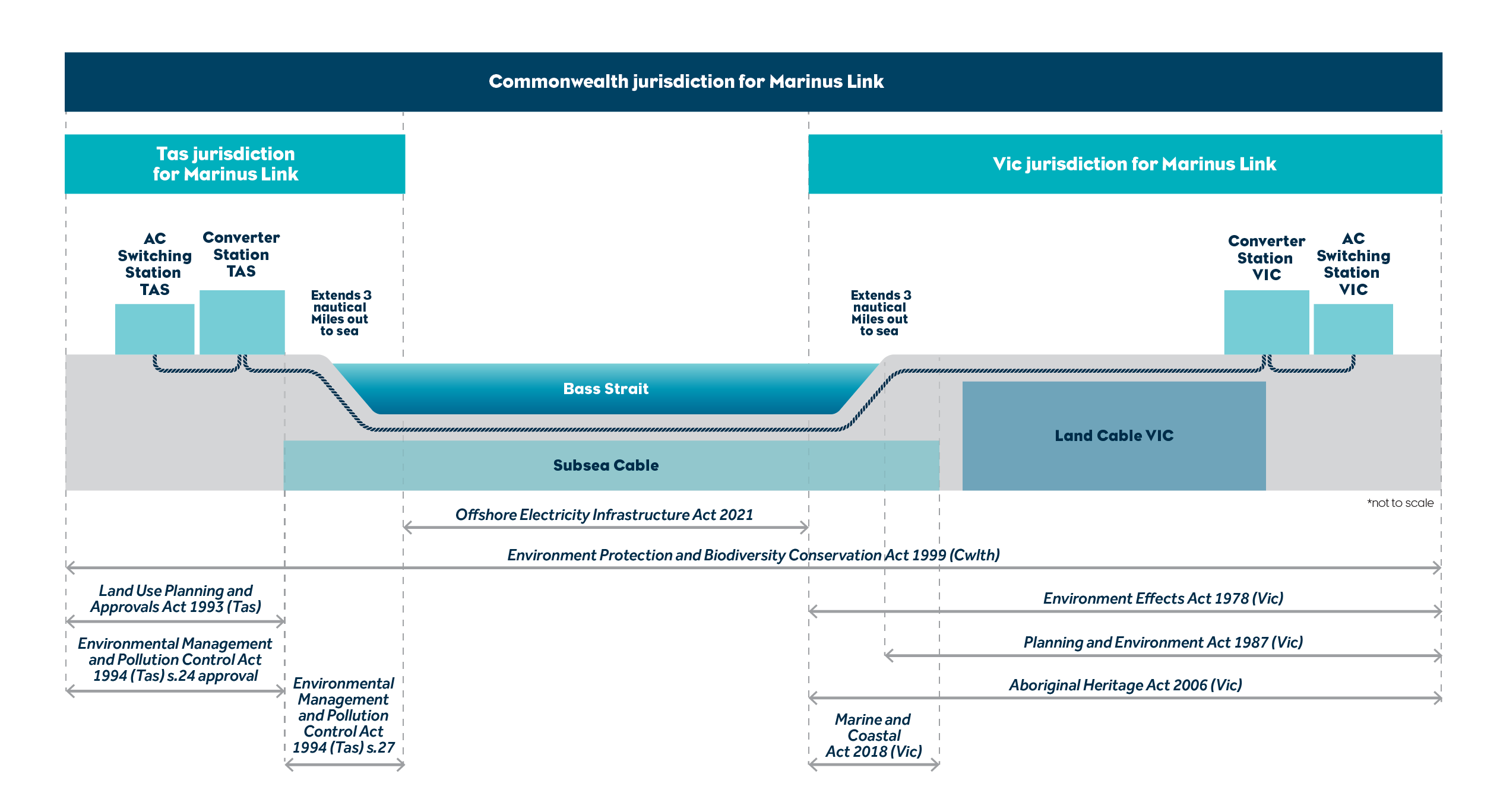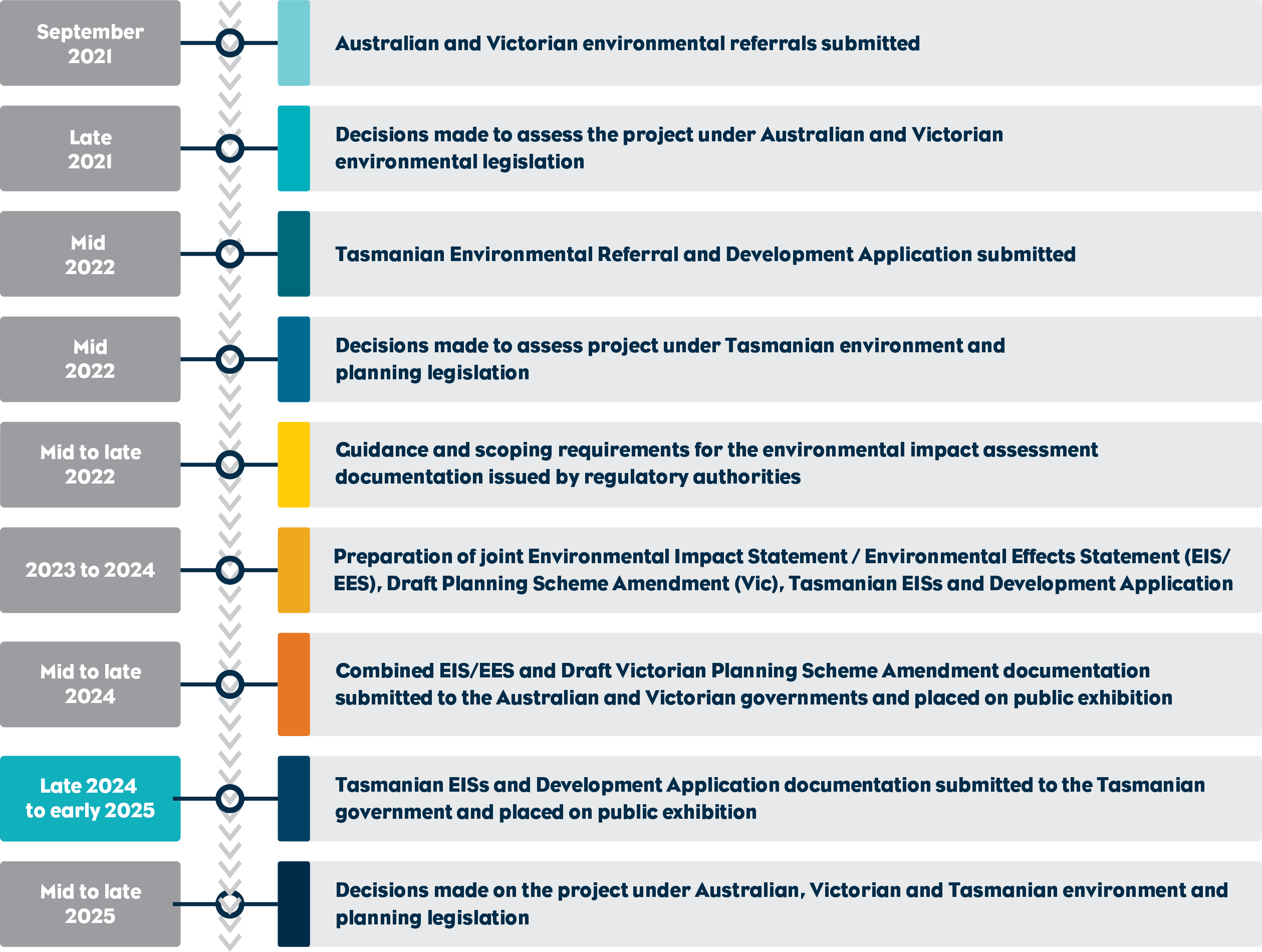This page provides information about the primary environment and planning assessment processes for Marinus Link.
Marinus Link is a complex project, crossing national, state and local jurisdictions. The project needs to be assessed and approved under the planning and environment laws relevant to each of the Commonwealth, Victorian and Tasmanian jurisdictions. Where possible, Marinus Link and the relevant regulatory authorities have aligned the assessment process across the jurisdictions.

In addition to the primary approvals required under Commonwealth, Victorian and Tasmanian jurisdictions, a number of secondary approvals and consents will also be required for the project.
As the requirements for secondary approvals are generally confirmed after the detailed design has been completed, secondary approvals would be sought by the contractors after the primary approvals under the Commonwealth, Victorian, and Tasmanian jurisdictions have been obtained.
Commonwealth approvals
As the project extends into jurisdictions of Commonwealth land and waters, the project requires assessment under Commonwealth legislation. Primary approvals under the Commonwealth jurisdiction include:
- Environment Protection and Biodiversity Conservation Act 1999
- Offshore Electricity Infrastructure Act 2021
Environment Protection and Biodiversity Conservation Act 1999
The Environment Protection and Biodiversity Conservation Act 1999 (EPBC Act) is Australia’s national environmental law. As the project is located within an Australian marine area and has the potential to have an impact on matters of national environmental significance, the project was referred to the Australian Environment Minister to determine whether assessment and approval is required under the EPBC Act.
A combined draft Commonwealth EIS under the EPBC Act and Victorian Environmental Effects Statement under the Environment Effects Act 1978 was prepared through a coordinated process and published for comment from 31 May 2024 to 12 July 2024. The finalised EIS under the EPBC Act comprises the draft EIS, the Addendum, and their attachments and appendices and are available to read here.
Following the submission of the finalised EIS and final assessment, DCCEEW issued approval for the Marinus Link project to be constructed and operated under certain conditions on 28 July 2025. Further details can be found here on The EPBC Public Portal.
Offshore Energy Infrastructure Act 2021
The Offshore Electricity Infrastructure Act 2021 (OEI Act) is the primary Australian legislation regulating the development of offshore renewable energy and electricity transmission infrastructure in Commonwealth waters. In relation to the Marinus Link project, the OEI Act applies to Commonwealth waters between Tasmanian and. Victorian coastal waters. A transmission and infrastructure licence for the project is required under the OEI Act.
An application for a transmission and infrastructure licence under the OEI Act was submitted on 4 July 2025 to the Registrar (National Offshore Petroleum Titles Administrator) for assessment.
A design notification scheme and approval of a management plan under the transmission and infrastructure licence is required prior to commencement of construction of the project within the Commonwealth marine area. The design notification scheme and the transmission and infrastructure licence will be informed by the conditions of the EPBC Act approval.
Additional updates regarding the transmission and infrastructure licence under the OEI Act will be communicated as they become available.
Victorian approvals
As the project extends into Victorian land and Victorian coastal waters, the project requires assessment under Victorian legislation. Primary approvals under the Victorian jurisdiction include:
- Environment Effects Act 1978
- Planning and Environment Act 1987
- Marine and Coastal Act 2018
- Aboriginal Heritage Act 2006
Environment Effects Act 1978
The Environment Effects Act 1978 (EE Act) is for the assessment of proposed projects deemed capable of having a significant effect on the environment. Desktop studies indicated that the project is capable of having a significant effect on the environment and as such was referred to the Planning Minister to determine whether assessment is required under the EE Act.
A combined draft Commonwealth EIS under the EPBC Act and Victorian EES under the EE Act has been undertaken through a coordinated process, resulting in the combined EIS/EES. The combined EIS/EES is available to read here.
On 18 May 2025, the Minister for Planning issued their assessment of the environmental effects of the project under the EE Act that concluded that the Marinus Link project can proceed with acceptable environmental effects and provided recommended refinements to environmental management for adoption. For further details on the Victorian Minister’s assessment, click here.
The Planning Minister’s assessment will inform Victorian statutory decision-makers responsible for approvals under legislation, including the Planning and Environment Act 1987 and the Marine and Coastal Act 2018.
Planning and Environment Act 1987
Amendment of the Latrobe and South Gippsland Planning Schemes is required under the Planning and Environment Act 1987 (Vic) (P&E Act). The project is implemented by the preparation of a Planning Scheme Amendment (PSA) to amend the Latrobe and South Gippsland Planning Schemes to apply a Specific Controls Overlay to areas where the project is proposed within Victoria (on land).
The Planning Scheme Amendment (PSA) including Incorporated Document under the P&E Act was approved by the Victorian Planning Minister on 21 August 2025 and gazetted on 12 September 2025. Gazetted documents can be found here.
The Environmental Management Framework (EMF) including Environmental Performance Requirements (EPRs) which provides the governance framework for the management of environmental impacts under the PSA was endorsed by the Planning Minister on 28 October 2025.
Marine and Coastal Act 2018
The Marine and Coastal Act 2018 (MACA) in Victoria, Australia, provides a framework for the integrated and coordinated planning and management of the state’s marine and coastal environment. Consent under Section 68(3) the MACA is required for the project for the use, development and works on marine and coastal crown land. A consent application under the MACA for the Marinus Link project is in development. The consent application will be informed by the Victorian Planning Minister’s assessment and the conditions of the EPBC Act approval.
Aboriginal Heritage Act 2006
The Aboriginal Heritage Act 2006 (AH Act) serves as the Victorian legislation to provide for the protection of Aboriginal cultural heritage in Victoria. The AH Act is applicable to the cultural heritage values in Victoria and within coastal waters. Three Cultural Heritage Management Plans (CHMP) are in development to address the management and protection of Aboriginal cultural heritage values for the Victorian components of the project. The three CHMP’s required for the Marinus Link project includes:
- CHMP 18201: covers land from Hazelwood to Mardan under the jurisdiction of the Gunaikurnai Land Waters Aboriginal Corporation (GLaWAC) in their capacity as a Registered Aboriginal Party (RAP), excluding several parcels north of Mardan that fall within CHMP 18244.
- CHMP 18244: covers land between Mardan and Waratah Bay not assigned to a RAP, excluding the Victorian shore crossing.
- CHMP 20684: covers the Marinus Link project’s Victorian shore crossing component at Waratah Bay and includes terrestrial and underwater components in an area not assigned to a RAP.
Tasmanian approvals
Separate approvals are required under Tasmanian planning and environment legislation for the project components located in Tasmania. Primary approvals required under Tasmanian legislation include:
- Land Use Planning and Approvals Act 1993 (LUPA Act)
- Environmental Management and Pollution Control Act 1994 (EMPC Act)
A development application under the LUPA Act has been prepared for the Heybridge Converter Station components of the project. Two EIS’s under the (EMPC Act have been prepared for the Heybridge Converter Station and the Heybridge Shore Crossing components of the project. The EIS for the Heybridge Converter Station and the Heybridge Shore Crossing can be found here.
Environmental assessments timeline

Follow us on our socials